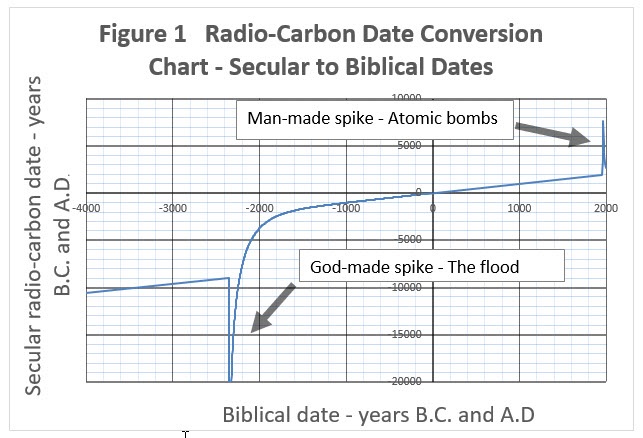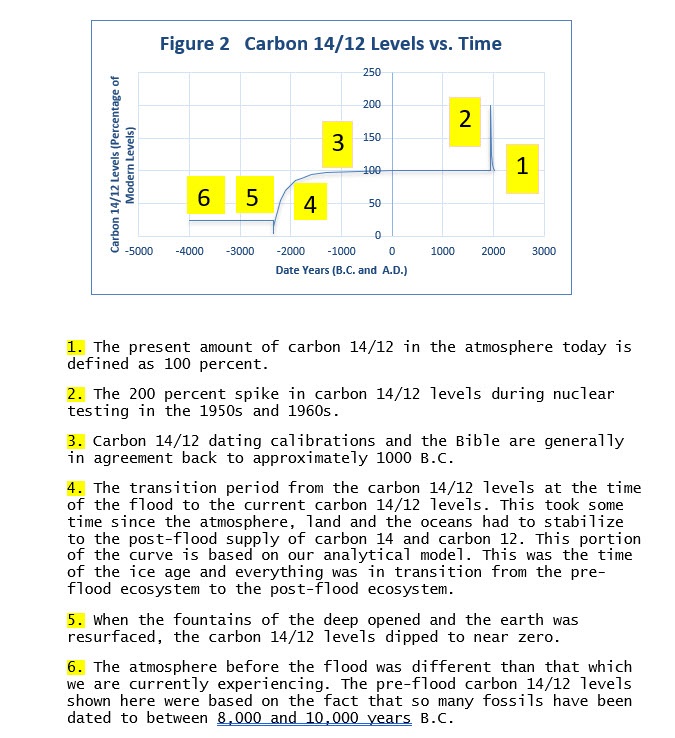Neanderthals have been carbon-dated to 30,000+ years before present; extinct dire wolves have been dated to 10,000+ years before present, and coal has been dated to 20,000+ years before present. However, the Bible proclaims a young earth, approximately 6,000 years old. How can these differences be rectified? We, at Genesis and Genetics, have concluded that the carbon levels are generally correct, but the calibration is wrong. Secular science assumes no significant catastrophes such as Noah’s flood; however, if we consider the flood, we find that:
Noah’s flood significantly influences radiocarbon dating.
This paper offers the following radio-carbon conversion chart, which can be used to convert secular science carbon dates to Biblical dates. This chart assumes that (1) the Bible dates are correct, and (2) a global catastrophic flood did happen, and (3) the secular radio-carbon values are correct. The following chart may be used to convert any secular science radiocarbon date to a Biblical date, or you can CLICK HERE to go to our Radiocarbon Biblical Date Calculator.
Figure 1 requires the following points of explanation:
1. All dates more recent than approximately 1,000 B.C. are the same for the secular and Biblical calibrations.
2. There is a human-made spike, the atomic bomb testing of the 1940s and 1950s. They are similar in form, and both had significant effects on Carbon 14 amounts.
3. The amount of Carbon 14/12 ratio before the flood was constant and decayed according to its half-life.
4. The Flood suddenly reduced Carbon 14/12 which explains how secular carbon dating is so different than Biblical. The year of the flood, 2348 B.C., renders vastly different fossil dates depending on the exact time of death of the creature being dated.
5. For some secular dates, there can be several Biblical dates. For instance, consider 10,000 B.C., the Biblical calculator gives three possibilities: 3398 B.C., 2348 B.C., and 2250 B.C. The 3398 B.C. date would be someone who died before the flood and had his grave washed to a place where anthropologists could find it. The 2348 B.C. date would be someone who died in the flood, not at the onslaught, but several weeks or months later. They would have lived on one of the massive rafts of debris or in a boat other than the Ark. The 2250 B.C. date would apply to one who died 98 years after the flood.\
6. The period between the flood and 1,000 B.C. was the flood-recovery period, which was also the ice age.
Background
God told Noah that He would destroy the earth with a flood (Genesis 6:13). The flood was a catastrophe of Biblical proportions. The land surface was washed, damaged, and resurfaced as the rains came down. The atmosphere was washed clean by the torrents of rain. The oceans were stirred as the fountains of the deep opened and accompanied by earthquakes and volcanoes. All these happenings changed the carbon quantities of the atmosphere, the land, and the sea.
The basis for Conversion Chart
Radiocarbon dating is a function of the ratio of the amount of carbon-14 divided by the amount of carbon-12. Figure 2 provides a time history estimate of carbon 14/12 levels in our atmosphere. This estimate is based on the assumptions that the carbon 14/12 levels were constant before the flood, dipped to very low levels during the flood, and recovered to the levels we have now. The highlighted numbers in Figure 2 correspond to the explanatory notes.
Additional Supporting Evidence for the Above
Atmospheric carbon values can change quickly.
Our world is continually balancing the amounts of carbon in the atmosphere, the oceans, and the soil, and this balance does not discriminate between carbon-12 and carbon-14, they mix homogeneously. Fortunately, we have data regarding sudden changes in carbon-14 levels and the atmosphere’s response to these sudden changes. There was a sudden  injection of carbon 14 in the 1950s and 1960s during the atomic bomb tests, and these tests can help us understand the effects of sudden changes to carbon 14/12 levels. The nuclear testing caused the carbon 14 values to skyrocket in the atmosphere while the carbon 12 remained the same; carbon-14 levels doubled from the pre-atomic-testing values (Reference 1). Carbon 14 has a half-life of 5730 years and had it not been for the dry land and the oceans, it would have taken 10s of thousands of years to recover to the pre-atomic-testing levels, but, surprisingly, it recovered quickly, in just a few decades. Equilibrium was reached quickly due to the carbon-14 absorption in the land and sea. This atomic testing carbon-14 “spike” is depicted in Figures 1 and 2. This is a human-made spike, but the God-made “spike” can also be seen in both figures.
injection of carbon 14 in the 1950s and 1960s during the atomic bomb tests, and these tests can help us understand the effects of sudden changes to carbon 14/12 levels. The nuclear testing caused the carbon 14 values to skyrocket in the atmosphere while the carbon 12 remained the same; carbon-14 levels doubled from the pre-atomic-testing values (Reference 1). Carbon 14 has a half-life of 5730 years and had it not been for the dry land and the oceans, it would have taken 10s of thousands of years to recover to the pre-atomic-testing levels, but, surprisingly, it recovered quickly, in just a few decades. Equilibrium was reached quickly due to the carbon-14 absorption in the land and sea. This atomic testing carbon-14 “spike” is depicted in Figures 1 and 2. This is a human-made spike, but the God-made “spike” can also be seen in both figures.
The deep oceans are deficient in carbon-14
Another point of evidence is that even today there are vast differences in the amount of carbon 14 in the various depths of water; for instance, right now, some of the deep ocean has water that carbon dates to 2400 years before present, and the average deep ocean water dates to 1400 years before present (Reference 2). Therefore, it is easy to conclude that the pre-flood deep oceans contained almost no carbon-14. Plus, this deep ocean water would mix with the “fountains of the deep” water which would contain no carbon-14 but much carbon-12.
The carbon-12 released by the earthquakes and volcanoes reduced the carbon-14/carbon-12 ratio.
Since carbon dating uses the ratio of carbon-14 to carbon-12, the additional amount of carbon-12 would make the ratio smaller, which would also result in dates older than the true dates. Presently our atmosphere contains approximately 800 gigatons of carbon. This carbon comes from volcanoes and photosynthesis of plants. Currently, we are having volcanoes that occasionally erupt, but also emit small amounts of carbon while dormant, but during Noah’s flood, there would be massive eruptions and fissures spewing large amounts of carbon. This carbon would be pure and carbon-14 free.
Nearly 100 percent of the carbon in our body is replaced annually. (Reference 3)
The Biblical narrative implies that many creatures did not die at the flood onset. It appears that there were huge rafts of debris, possibly hundreds of miles in breadth and thousands of feet in depth. Therefore, creatures, including humans, could have survived for weeks or even months on these rafts of debris. The longer a human, animal, or plant survived would significantly affect their amount of carbon-14/12. Much radiocarbon testing uses collagen, which is replaced in the body rapidly.
The atmosphere was different before the flood.
We know that before the flood, there were giant insects such as dragonflies and cockroaches. These enormous insects and others have been documented in the fossil record (Reference 4). Secular science had concluded that these giant insects could only have lived at a time when the oxygen levels in the atmosphere were 30 to 50 percent higher than what we currently have. This ancient atmosphere would, most probably, have reduced the production of carbon-14 simply because there would be less nitrogen available to convert to carbon-14.
Summary
In summary, the global flood has a significant effect on carbon dating. The fountains of the deep opened, spewing out carbon-14-free water; the surface of the earth was covered with carbon-14-free silt; the massive volcanic eruptions flooded the atmosphere with carbon-12, and the carbon-14/carbon-12 ratio was reduced close to zero. Since carbon is replaced quickly in the body of living creatures, the exact time and circumstance of death affect the carbon dating results.
Takeaways from conversion chart
Here are some exciting takeaways we can collect from this chart in figure 1:
1. The “flood spike” of carbon 14/12 explains why secular scientists have concluded everything is older than the Biblical dates.
2. The Bible implies that all the creatures did not die until just a few months before the landing of the Ark; therefore, the carbon 14/12 ratio was changing rapidly in all living beings during this period. The resulting dates could vary by thousands of years. Looking at the chart in Figure 1, we can see a vertical line at the year 2348. During this single year, many humans, plants, and animals died. Some during the initial onslaught and some during the ten months or so while on rafts or boats. Each casualty reflected the carbon ratio at that time. Their bodies were rapidly replacing low carbon14 from the atmosphere and the food chain.
3. Any radiocarbon date more recent than 1000 B.C. is generally accurate whether the secular or Biblical flood calibrations are used.
4. The chart shows two spikes, one from the atomic bombs and one from the flood. Both spikes are abrupt and recover rapidly.
5. Example: Otzi, the Iceman has been dated to 5,300 years before present. Using the conversion curve, this would convert to 1900 B.C., which would mean that Otzi and Abraham were contemporaries. Otzi’s DNA clearly places him in the category of modern man.
6. Neanderthal fossils carbon-date to over 28,000 years or more. Converting the Neanderthal carbon dates to Biblical dates we can see that they all died in the flood.
References:
1.http://web.science.uu.nl/AMS/Radiocarbon.htm
2 https://agupubs.onlinelibrary.wiley.com/doi/full/10.1029/2007JC004095
3.https://www.reddit.com/r/askscience/comments/g63l6/are_98_of_the_atoms_in_the_human_body_replaced/
4.https://news.nationalgeographic.com/news/2011/08/110808-ancient-insects-bugs-giants-oxygen-animals-science/



Great Answers to ever haunting atheist questions and a relief to us believers
God reveals!! everything at the right time
Thanks a lot.